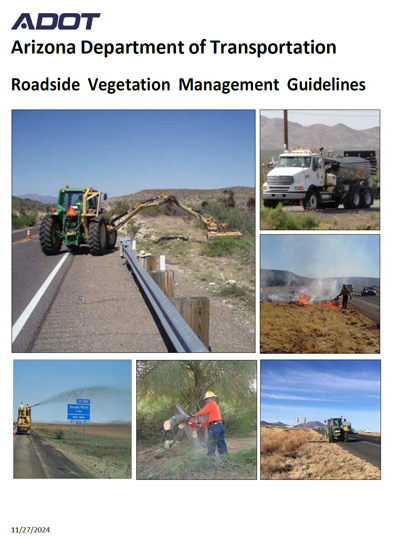Roadside Resources
Roadside Resources
Roadside design and management is integral to efficient highway planning, design, operation, and maintenance. These areas must be managed for multiple uses and benefits, including safety considerations, signage, utilities, water quality, aesthetics and habitat. Decisions on how to balance and manage these interests affects the appearance of the roadside and the user experience. Properly designed and managed vegetation complements the functions of the roadway, integrates the roadway into the surrounding landscape, and has a positive effect on the traveling public.
Roadside Resources provides support for roadside vegetation management during planning, design, construction, and maintenance and manages NEPA requirements for vegetation management activities, including the use of herbicides, with external agencies.
Map of Herbicide/Invasive Species Contacts
Roadside Resources coordinates with and supports programs throughout ADOT, including:
- Roadside Development,
- Environmental Planning,
- Engineering and Construction,
- Central Highway Maintenance, and
- Maintenance and Landscaping staff in the ADOT Districts.
ADOT Roadside Vegetation Management Guidelines
ADOT’s goal for roadside management is to follow Integrated Vegetation Management (IVM) practices. IVM promotes the establishment of low-maintenance beneficial vegetation and the suppression of unwanted vegetation through the integration of biological, cultural, manual, mechanical, and educational methods. Chemical controls are used only when needed. IVM uses plant growth characteristics, principles of plant succession, and knowledge of natural and human-related factors affecting environmental change to achieve management goals, while minimizing impacts on the environment.
Noxious and Invasive Weeds
Landscape Care and Maintenance
Revegetation
- Roadside Development (in Roadway Engineering)
- ADOT Blog – Relocating plants on Loop 101
- ADOT Blog – Plant Salvage on Loop 303
- Seeding guidelines
- Salvage guidelines
- Methodology for Determining Final Stabilization
- Evaluation of Salvage and Replanted Native Plants on ADOT Projects. ADOT Research Report SPR-587 (2012)
Coordination with Land Managing Agencies
ADOT-BLM-FHWA-USFS Four Agency Partnership
- Roadside Resources coordinates the Herbicide Subcommittee meetings
- Guidelines for Highways on BLM and USFS Lands
- ADOT Public Partnering
Bureau of Land Management
- Arizona State Office
- BLM Arizona Invasive Species Contacts
- Conservation Measures for ADOT Herbicide Treatments on BLM Lands
- FHWA FONSI for ADOT Herbicide Treatment on BLM Lands
- ADOT-BLM Annual Maintenance Plan
- Environmental Assessment for ADOT Herbicide Treatment Program on Bureau of Land Management Lands in Arizona
US Forest Service
Bureau of Indian Affairs
Arizona State Agencies
Coordination of Vegetation Management and Herbicide Use with Regulatory/Permitting Agencies
Arizona Department of Agriculture
- Arizona Native Plant Law
- Pest Management Division (PMD): Licensing for herbicide applicators
ADEQ
- Water Resources (in Environmental Planning)
- Pesticide General Permit
US Fish and Wildlife Service
- Biological Resources (in Environmental Planning)
- Recommended Protection Measures for Pesticide Applications in Region 2 of the USFWS (2007) (scroll down to the Environmental Contaminants Reports section)

